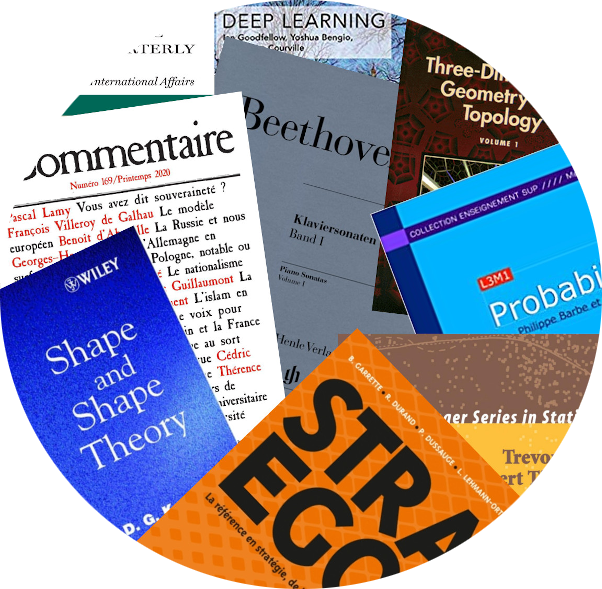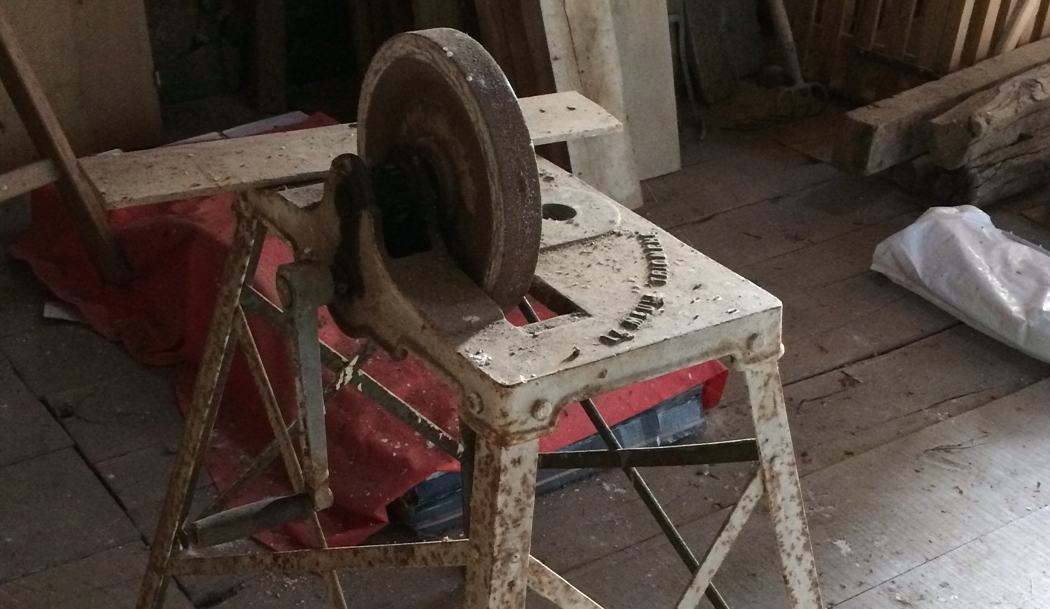 Philippe Barbe
Philippe Barbe

|
The old grinderby Philippe Barbe
08 Sep 2021
|
The old grinder is still in the barn, ready to sharpen whatever farming tool was well used. A sharpening wheel, a couple gears, a handle, a base, these are all the parts.
My friend John who is visiting comes along to sharpen an ax. He sees the tool, and I ask him to tun the handle. The gears multiply the speed at which his arm turns the handle, giving the wheel a fast, yet not too fast rotation. A lower speed would not be as efficient. A higher speed would overheat the metal, making it more fragile. As I am applying lightly the head of the ax on the stone, the lever made by the handle makes his motion effortless.
The squeaky sound of the stone grinding the ax signifies the abrasion of the metal by the stone. Nice sound, that does not cover our discussion.
In a minute, the ax is sharp again.
John marvels at the tool. He notes how smart people have been to come up with a simple yet amazingly effective tool. How many millennia of farming, metalsmith and stone working did it take until this tool reached that level of perfection? The effectiveness of the tool is amazing. It is adapted to the task and to the people doing it.
In this joint work, we are equally important, and the achievement is ours. The one turning the handle knows that steadiness contributes to a more even blade, and knows that the other cannot sharpen alone. Turning the wheel alone does not achieve anything. The one sharpening controls the tool to be sharpened but is totally dependent on the other for the tool to be effective. Hence, the tool creates this mutual dependence, making us equal, and requiring our collaboration to achieve our goal.
I did not sharpen the ax. We did.
What is also amazing is in how in literally one minute, it created a sense of shared experience which is rather unique, and an emotional connecThe wall is 900 years old.
The stones set in mortar, keep on their unexposed faces traces of the hands that touched them around 1150.
Next to this really old building, a house, more recent, maybe from the 19th century, its stones fairly well cut making a more even wall, bears witness to how human ingenuity improved stone cutting and masonry over the preceding 800 years.
Less than 100 years later, tall city buildings constructed with reinforced concrete, covered by reflective glass windows… all identical, indistinguishable, perfect… assert rapid progress in engineering, construction materials and techniques.
In 2000 I watched a building rising across the street from my apartment. Every 3 days, a small crew of about 20 would complete a floor in a neatly choreographed sequence of tasks: placing the forms, pouring the walls, placing the support for the next floor, pouring the floor. The efficiency and predictability defied imagination, and only a particularly cold and snowy day that made pouring concrete hazardous could stop the construction.
Unlike stones that are individually unique, concrete comes as liquid, fungible, creating surfaces where no element can be distinguished. Also unlike stones placed by a mason, no one in particular set the concrete. A crew did it.
As woodworkers know, the difference between old tools and modern tools is in the relation of the tool with the material: old tools go through the material, while the material goes through the new tools. The saw exemplifies this: a hand saw cuts through the wood, while wood is fed through a table saw. Concrete, by being poured in the forms, goes though the tool. In contrast, a trowel takes the mortar and lays it to connect the stones.
Where the mason looks for the right stone, one at a time, the stone that will fit well and look good, the building crew opens a valve from the concrete mixer and the liquid stone fills the space where it will set.
What is the intent?
The mason is an artisan in charge of the conception and the execution of the building of the wall. Taking a stone to add to the wall, the intent is to find the right stone that fits well in that specific space. Fitting that stone with mortar, the intent is to build the wall. Building the wall, the intent is to build the house. Building the house, the mason’s intent is to find reward, financial and moral, in creating a lasting piece for the enjoyment of its occupants.
All such individuality has been lost in the building of a concrete wall which making has become an abstraction, composed of perfectly reproducible sequences which ensure consistency of execution and reproducibility.
The profound sense of ownership of the work and the connection with those who will inhabit the home is what distinguishes the artisan from other workers.
While the building crew is gratified by having built 40 floors in 2 buildings with 320 apartments in a year, the thousand people who will inhabit these buildings are an abstraction which will materialize later. Such a pace and scale of building allows the vast majority of people to have shelter.
I like cities for what they say about humans. There is a great efficiency in well-organized cities.
Buildings signal our own ambition but cities are seldom built on purpose. They arise because some geographic feature, typically a river, makes the surroundings hospitable. Then they get organized as they grow.
Tall glass buildings look the same all over the planet. An original tower is yet another original tower, and the “tallest” soon loses its title, while the oldest is demolished. Their universality is where their aesthetic is, perfect assemblies of slick glass, rising to impressive heights in a perfect verticality.
Cities are an ode to our gregariousness, yet the separation by a wall, the ride through the elevator are enough to barely say hello.
I like rural areas for a different thing they say about humans. There is a great human connection in the countryside.
The road that separates houses invites us to talk across it to comment about the weather or the harvest.
Buildings raise out of necessity, a home, a shed, a hangar. Rural areas themselves arise out of necessity: we need to eat and therefore to grow food.
An original house is the house that we saw on a specific location and associated to a specific day in our life. The aesthetic is in the individual appearance, the variations that shows that it is man-made, a scale that can be grasped by a person.
It is not that one is better than the other. They simply serve different functions and function differently.
Some people want to live in cities, others prefer the country side, and others are fine everywhere.
The changes in the way we construct our walls is emblematic of the changes in the way we work at large.
Which product has not gone through standardization, technical evolution?
Which partitioning of the work has not made it more efficient, more perfect, less human, yet serving a larger share of mankind?
Beyond appreciating the different types of walls, considering how and why walls are built gives us a way to look at ourselves, what we do, how we do it, measure what we accomplish, build, create… what we have lost… and reflect on what we want to do, how we want to do it, and with what purpose. tool is sharp, like new, and the coming work will be easier. But more than this future, the immediate past of the achievement creates a bond between us.
The more recent grinders are electrical. By allowing not to rely on someone else, their seemingly self reliance signals in fact the opposite, the end of self-reliance: should you need to sharpen an ax after a storm knocked off the power, you would fail. Without the electricity, whose production and transportation depends on a large amount of people, the electrical grinder is useless. But we live in the illusion that because it is enough to turn a switch and we can operated it alone, we are self sufficient. In reality, the tool in itself contains an abstraction of the work needed to operate it, and in this abstraction, all people involved in making the tool effective have disappeared.
By the simple action of a switch, the wheel turns. The motor is protected by a case, hidden, mysterious. You plug the tool, and by the action of a single finger, the wheel turns. How does it work? We do not know because we do not see it. And even if we see a motor, how does it work? A magnet, some wiring, and some physics may give you a rationalization of the principles behind it.
We contemplate the old tool, longing for its ability to bring us together. What good is efficiency if it takes us apart?
Why do I care about this grinder? Why is it important?
Anyone who builds a team needs grinders which build cohesion, reliance on each others, and trust. We all need some endeavors creating a shared sense of accomplishment. What is particularly nice about the old grinder is its effectiveness not only in sharpening, but in quickly creating bonds between people. As a leader you need to think what will be your grinder. What is your simple endeavor, your simple tool that will bring people together, give them a sense of accomplishment and solidarity that is the mark of a functioning team